Writing Samples - Web Articles
Around the World in One Year – Part 4
Relics of Grand Civilizations: Egypt, Istanbul, and Greece
A few weeks would reveal the cultural achievements of thousands of years in human history. Constantly in awe, we stared at, touched, and learned about the overwhelming remains of Ancient Egypt, the Roman and Ottoman Empires, and the Greek republic.
Egypt
Surreal, proud, and honorable, the pyramids stand in the desert next to the life-giving source of Egypt, the Nile. They seem to defy time and change. The pharaohs built these awesome structures as a testament to their power and to ensure a luxurious journey into the afterlife. As if following a call to worship, we were drawn to experience the mysteries of antiquity along the Nile.

At Sakkara we visited the step pyramid, the first attempt at this type of construction, built in 2630 B.C.E. The Egyptians worshipped the sun in form of their main god called Ra and believed that the pyramid form would gather and store the maximum solar energy. The Pyramids of Giza constitute the finest examples of this tomb construction. Standing next to the base of the largest pyramid (Khufu), we could hardly see the 481-foot-high peak but realized the gigantic measurements of the limestone blocks used for building. We were able to crawl into the smallest of the three pyramids and sense the hot, mystical air inside a tomb chamber. We fought our way through tourist masses for an extended glimpse of the Sphinx, whose wise expression gazes somewhat disillusioned toward modern Cairo.
The advancement of the ancient Egyptian civilization became most evident at the Cairo Archaeological Museum. Giant statues carved out of single blocks of granite include the finest muscular detail. Papyrus papers store ancient stories written in hieroglyphics and illustrated with delicate pictures. Countless glass cases display complex tools for writing, medicine, and agriculture. The exhibit of King Tutankhamon's tomb treasures include the famous mask, wooden folding chairs inlaid with gold and precious stones, game boards, chariots, jewelry, and sandals, all produced 3,000 years ago for the king's afterlife.
After a short flight the next morning, we embarked in Luxor on a four-day Nile cruise. We spent most of the afternoon exploring Karnak Temple, a 250-acre complex of temples, chapels, and obelisks. The surfaces and walls of each structure are decorated with relief carvings. With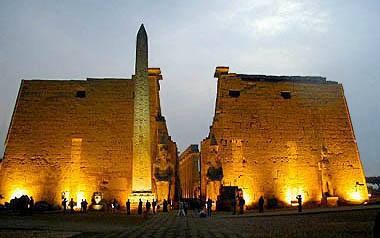 134 massive columns, the temple's hall is the largest columnar structure in the world. Only a mile away stands Luxor Temple (right). This equally impressive structure was once linked to the Temple of Karnak by a wide stone avenue lined with sphinxes. Some parts of this holy pathway have been excavated.
134 massive columns, the temple's hall is the largest columnar structure in the world. Only a mile away stands Luxor Temple (right). This equally impressive structure was once linked to the Temple of Karnak by a wide stone avenue lined with sphinxes. Some parts of this holy pathway have been excavated.
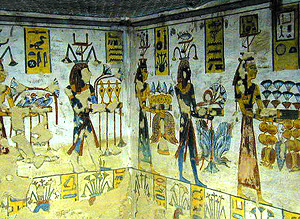
With the boat still anchored in Luxor, we left early the next morning for a drive to the Valley of the Kings. The New Kingdom pharaohs probably chose this site because the desert mountain above the outcrop resembles a pyramid. We had time to walk into three tombs, each of them decorated with astonishing carvings. Many wall decorations still exhibit the original colors (left).
The temples of Ramses II and Nefertary at Abu Simbel had to be moved to escape the waters of Lake Naser, created by a large dam in Aswan. The edifices had been carved completely out of limestone mountains. For the move, the temples were cut out of the mountain face and the entire hill 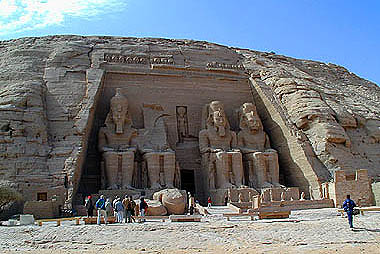 was reassembled on the newly created shore. Four gigantic statues of Ramses II, the most powerful and longest-reigning pharaoh of Egypt, guard the entrance to his temple (right). More of the ideal figures stand tall inside the temple hall. With this temple, Ramses II established himself as a god and forced the population of Abu-Simpel to worship him as an immortal deity. The pharaoh ordered a temple for his beloved wife Queen Nefertary to be built into the same mountain. The colorful wall reliefs within this building have survived the centuries with only minor damage.
was reassembled on the newly created shore. Four gigantic statues of Ramses II, the most powerful and longest-reigning pharaoh of Egypt, guard the entrance to his temple (right). More of the ideal figures stand tall inside the temple hall. With this temple, Ramses II established himself as a god and forced the population of Abu-Simpel to worship him as an immortal deity. The pharaoh ordered a temple for his beloved wife Queen Nefertary to be built into the same mountain. The colorful wall reliefs within this building have survived the centuries with only minor damage.
We had stepped inside the wonders of the most stable civilization we know. Was the existence of this empire and its buildings and artifacts a result of harsh dictatorship and slave labor, or did these people enjoy the daily work that created such marvels of art and architecture? We want to believe the latter and remember the glorious version of Egypt.
Istanbul
Seat of three empires. Crossroads of the crusades. Meeting place of Europe and Asia. Istanbul has played a major role on the stage of world history.
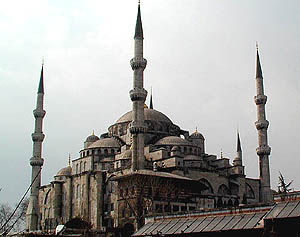 The Blue Mosque (left) is one of Istanbul's most famous landmarks. The inside is decorated, as are many mosque interiors around Istanbul, with famous hand-painted tiles in red, blue, and green. A huge dome and numerous half domes, all lit by stained-glass windows, add to the splendor of this beautiful structure.
The Blue Mosque (left) is one of Istanbul's most famous landmarks. The inside is decorated, as are many mosque interiors around Istanbul, with famous hand-painted tiles in red, blue, and green. A huge dome and numerous half domes, all lit by stained-glass windows, add to the splendor of this beautiful structure.
Next door, excavation teams found ruins from an old Roman palace. A series of mosaic floors remain in their original locations; other fragments hang on the walls. One square foot includes approximately 900 tiny stone tiles.
 The world-famous bazaar (right) is located in an endless maze of colorful hallways filled with every product the shopper may desire. Small stores line the narrow streets, selling handcrafted carpets, jewelry, leather goods, spices, and many other items. Walking from one aisle into the next, you soon lose your bearings and must exit to reorient yourself.
The world-famous bazaar (right) is located in an endless maze of colorful hallways filled with every product the shopper may desire. Small stores line the narrow streets, selling handcrafted carpets, jewelry, leather goods, spices, and many other items. Walking from one aisle into the next, you soon lose your bearings and must exit to reorient yourself.
The equally vast complex of the Topkapi Palace is designed around a series of open courtyards, and once was home to about 2,000 people: the sultan, his extensive harem and family, and their staff. We viewed the china collection and the priceless pieces displayed in the treasury. The harem, living quarters of the royal family, is a labyrinth of hallways leading to lavishly decorated rooms where only the sultan, his countless women, and eunuchs were permitted to enter. Here the wives and mistresses played out their intrigues and tried to win the sultan's attention.
The Hagia Sophia, largest mosque in Europe, has received attention from various religions since the fifth century. First a church and later converted to a mosque, the vast edifice is topped by a huge central dome, two half domes, and tall stained-glass windows. A number of large, original mosaics have survived in spectacular condition.
We spent our last morning inside the archaeological museum. The highlight of the exhibitions was a series of giant sarcophagi discovered in an ancient tomb near Istanbul. Intricate scenes and pictures are carved into the stone faces on all sides. Other rooms showcased Greek and Roman sculptures, sarcophagi, and various artifacts.
We had breathed Istanbul’s captivating atmosphere; gazed into airy interiors of many colorful mosques; imagined the conspiracies of the harem; joined the local life in bustling streets, bazaars, and tiny alleys. A shopping extravaganza, a cultural education, a feast for the senses!
Greece
We continued our pilgrimage to the sacred grounds of important civilizations. The Odyssey, the oracles, and ancient Olympic games came to life as we stood upon the locations of these epic events.
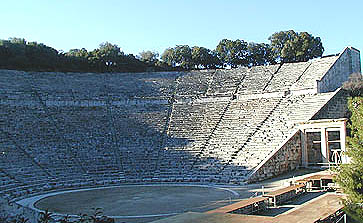 After exhausting visits to the famous sights of Athens, we welcomed a restful day exploring the grounds of Epidavros. The ancient Greeks retreated to this area to treat their ailments, relax their troubled minds, eat well, and enjoy the beauty of nature. The multi-acre complex, composed of healing chambers, temples, housing complexes, and baths, spreads over a secluded, wooded site surrounded by gentle mountains. The ancient Greeks used entertainment and sports as means of healing. Therefore, the spa site included a stadium and a large amphitheater (left), one of the best preserved of this period.
After exhausting visits to the famous sights of Athens, we welcomed a restful day exploring the grounds of Epidavros. The ancient Greeks retreated to this area to treat their ailments, relax their troubled minds, eat well, and enjoy the beauty of nature. The multi-acre complex, composed of healing chambers, temples, housing complexes, and baths, spreads over a secluded, wooded site surrounded by gentle mountains. The ancient Greeks used entertainment and sports as means of healing. Therefore, the spa site included a stadium and a large amphitheater (left), one of the best preserved of this period.
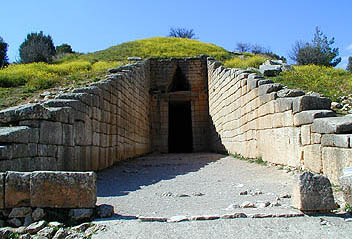 The ruins of ancient Mycenae require another whole day of exploration. Mycenae was one of the oldest Greek civilizations. The location and time period of this powerful kingdom coincide with Homer's Odyssey, which has caused scholars to consider the myth's factual merit. The impressive beehive-shaped burial chambers (left) contained many precious gold artifacts. The fortress is surrounded by thick walls built of huge stone blocks, which protected the powerful kingdom for hundreds of years until its mysterious demise.
The ruins of ancient Mycenae require another whole day of exploration. Mycenae was one of the oldest Greek civilizations. The location and time period of this powerful kingdom coincide with Homer's Odyssey, which has caused scholars to consider the myth's factual merit. The impressive beehive-shaped burial chambers (left) contained many precious gold artifacts. The fortress is surrounded by thick walls built of huge stone blocks, which protected the powerful kingdom for hundreds of years until its mysterious demise.
Ancient Olympia hides among the forests of an isolated low mountain area. The games of antiquity commenced every four years without interruption for more than 1,000 years. Standing among the ruins and inside the original Olympic stadium, we imagined the glory of these events and the gorgeous athletes competing for honor and a simple laurel wreath. The grounds and ruins preserve a peaceful, significant spirit.
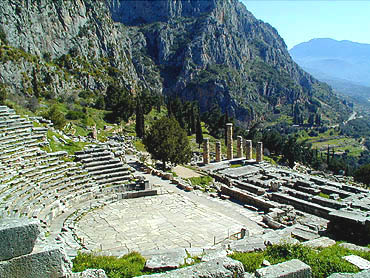 It is easy to understand why the ancient Greeks considered Delphi the center of the world. Situated on the slopes of a spectacular mountain peak, this striking natural amphitheater of steep rock tiers accommodates the Sanctuary of Apollo. All the Greek city-states built treasuries on the site, where they deposited sacrificial offerings to the gods. The buildings of the sanctuary climbed up the mountain in an organized fashion, starting with the treasuries, and followed by the Temple of Apollo (where the priests passed on the words of the oracle) and the amphitheater.
It is easy to understand why the ancient Greeks considered Delphi the center of the world. Situated on the slopes of a spectacular mountain peak, this striking natural amphitheater of steep rock tiers accommodates the Sanctuary of Apollo. All the Greek city-states built treasuries on the site, where they deposited sacrificial offerings to the gods. The buildings of the sanctuary climbed up the mountain in an organized fashion, starting with the treasuries, and followed by the Temple of Apollo (where the priests passed on the words of the oracle) and the amphitheater.
The images remain in our minds: the magnificent temple of the Acropolis rising from a steep hill in the middle of crowded Athens; the perfection carved into the sensuous bodies of antic sculptures; the size and elegance of a few towering temple pillars among blooming meadows and bright mountain cliffs ... the beauty of Greece will keep you divine company!
Visiting the sites of earlier civilizations delivers countless optimistic reminders: Amid wars and painful conditions, human minds always have and always will create art and give rise to magnificent beauty.